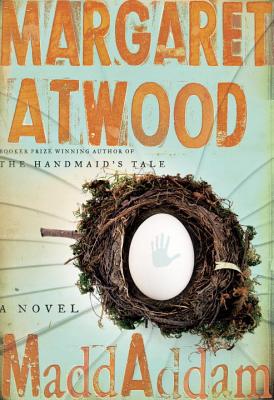by Margaret Atwood
Early on in the long-awaited conclusion to her MaddAddam trilogy, Margaret Atwood writes:
“There’s the story, then there’s the real story, then there’s the story of how the story came to be told. Then there’s what you leave out of the story. Which is part of the story too.”And in MaddAddam, at last, Ms. Atwood gives us all of the above.
It’s been a decade since I first read Oryx & Crake, and four years since I read The Year of the Flood. I loved both books, loved the way the two intertwined and complemented each other. So, in preparation for this final volume, I started by rereading the first two novels of the trilogy. Wow, oh wow, did they hold up well! I realize that not all readers have the time or inclination to revisit books they’ve already read, but in this case it was well worth the extra effort, if only to fully appreciate the connections between the three novels. I don’t believe that a trilogy was planned when Ms. Atwood wrote Oryx & Crake, and yet it was almost as if she had salted away loose ends a decade ago as part of some subconscious, brilliant master plan. For those who aren’t inclined to follow my suit, MaddAddam helpfully opens with a four-page summary entitled, “The Story So Far.” Personally, I wouldn’t consider reading this final volume without having first read the prior two at some point.
When last we visited with the God’s Gardeners, it was the post-pandemic Year of the Flood. We’d been on a harrowing journey narrated through the eyes and voices of two Gardeners, Toby and Ren. In MaddAddam, Toby is back as narrator, and while Ren is a secondary character in the novel, I have to admit that I missed her voice. This time around, the tale is told by Toby alone until late in the novel a surprising second narrative voice emerges.
And it’s appropriate that Toby tells the tale, because it is primarily (Finally!) the story of Zeb, a man that Toby has secretly desired for years. Up until now, Zeb has been an enigmatic character, always hard to pin down. In MaddAddam, it becomes clear that Zeb’s history is inextricably linked to that of Adam One and the God’s Gardeners, as well as that of Crake and the Crakers.
But in addition to looking backward, the story of Toby, Zeb, Snowman, the God’s Gardeners, the Crakers, and the “MaddAddamites” who engineered them, moves forward. The whole bunch of them are joined in an uneasy community. The Crakers are an alien intelligence. Says one of the MaddAddamites, “Their brains are more malleable than Crake intended. They’ve been doing several things we didn’t anticipate during the construction phase.” Amen to that! There are many unexpected complications of joining humans and Crakers together, many of them quite comic. The comic relief is welcome, because Atwood’s post-apocalyptic future is dark. Of all the Craker characters, there is really only one who stands out, a young boy christened Blackbeard. He befriends Toby, and is, simply put, adorable. He is also the entrée for readers into the Craker mind. Can it possibly be accurate to say he “humanizes” them?
There are many dangers facing this little tribe. Probably the most aggressive threat is that of the
Painballers—escaped prisoners who have all but lost their humanity. The matter of humanity is, I think, central to this tale because if humanity is to be measured among the characters, it’s a broad spectrum. The Gardeners and their allies are a fairly admirable bunch, trying to live in peace, sustainably, and protect the Crakers. While the Crakers have some extraordinary natural defences and abilities, left to their own devices in this harsh world, these childlike beings would surely perish. The Painballers are entirely human, but have regressed to an almost animalistic state. And then there are the pigoons—the enormous, genetically-engineered pigs that have acquired an unknown degree of human intelligence in addition to the transplant organ-compatibility they were designed for. The pigoons are a threat to all constituencies, and in MaddAddam, we learn a great deal more about these animals.
I can only write so much here, and yet it is a testament to Ms. Atwood’s epic achievement with this final volume that there is so much substance contained within a mere 416 pages. I want to discuss the role of mythology and written language within this tale, the allegorical elements, the cyclic nature of the story being told, and the connectedness of all things. And, I want to quote her at length, for the sheer intelligence of her thoughts, and the beauty of her expression of them. Truly, I could go on and on.
She has given us the story, the real story, and how it came to be told. Ms. Atwood has looked into our future with this trilogy. She has extrapolated trends in our culture today and carried them into a worst possible tomorrow. Her work is disturbing because her vision is undeniable. Different readers will get different messages from this tale, and will take away different lessons. Despite the darkness, I am left with a feeling of hope. And a very strong impulse to start talking with the bees.


No comments:
Post a Comment